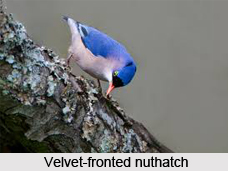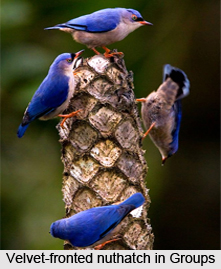 Velvet-Fronted Nuthatch is an Indian bird that bears a scientific name "Sitta frontalis" found in the Indian states and the Southern part of Asia. This bird is found in Indian states like West Bengal, Bihar, Odisha, Punjab, Haryana, Jharkhand, Chhattisgarh and many other Indian states of Southern part like Tamil Nadu, Kerala, Andhra Pradesh, Kanyakumari District, Telangana some parts of Konkan, Western Ghats Mountain Range in India.
Velvet-Fronted Nuthatch is an Indian bird that bears a scientific name "Sitta frontalis" found in the Indian states and the Southern part of Asia. This bird is found in Indian states like West Bengal, Bihar, Odisha, Punjab, Haryana, Jharkhand, Chhattisgarh and many other Indian states of Southern part like Tamil Nadu, Kerala, Andhra Pradesh, Kanyakumari District, Telangana some parts of Konkan, Western Ghats Mountain Range in India.
Category of Velvet-Fronted Nuthatch
Velvet-Fronted Nuthatch is a small passerine bird found in Pakistan, India and Sri Lanka east to south China and Indonesia. It is a member of the nuthatch family Sittidae.
Habitat of Velvet-Fronted Nuthatch
Velvet-Fronted Nuthatch is a resident breeder of all types of forests and woods, although open evergreen forest is the optimal habitat.
Feeding of Velvet-Fronted Nuthatch
Velvet-Fronted Nuthatch has the ability, like other nuthatches, to climb down trees, unlike species such as woodpeckers which can only go upwards. It is an active feeder on insects and spiders, and may be found in mixed feeding flocks with other passerines.
Call of Velvet-Fronted Nuthatch
Velvet-Fronted Nuthatch is a noisy bird, often located by its repeated "sit-sit-sit" call.
Size of Velvet-Fronted Nuthatch
Velvet-Fronted Nuthatch has the typical nuthatch big head, short tail and powerful bill and feet. It is 12.5 cm long. It is violet-blue above, with lavender cheeks, beige under parts and a whitish throat.
Bill of Velvet-Fronted Nuthatch
The bill of Velvet-Fronted Nuthatch is red, and there is a black patch on the forehead. The male also has a black supercilium.
Structure of Velvet-Fronted Nuthatch
The Female Velvet-Fronted Nuthatchs lack the supercilium and have a warmer under part colour. Juveniles are duller versions of the adult. There are four races differing in the shade of the under parts and the extent of white on the throat.
Nests of Velvet-Fronted Nuthatch
The nests of Velvet-Fronted Nuthatch are in tree holes or crevices, lined with moss, fur and feathers, or grass. Often the nuthatch needs to enlarge the hole, but a large hole may have the size of its entrance reduced by the building of a neat mud wall. Three to six eggs are laid, white speckled with red.











